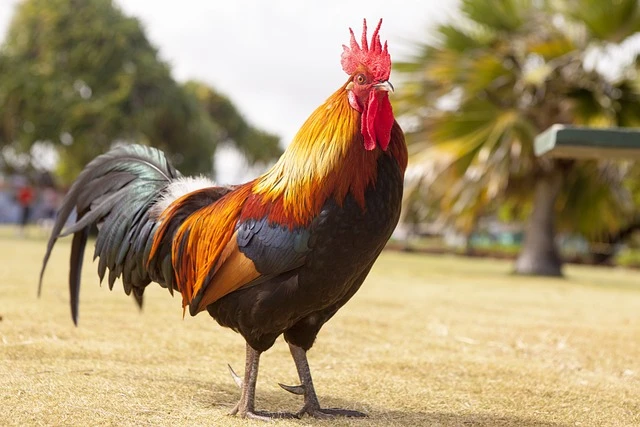Characteristics of Rooster
Habitat
Farms and rural areas
Diet
Omnivorous - seeds, insects
Lifespan
5-10 years
Weight
2.5-4.5 kg
Length
Region
Worldwide (domesticated)
Rooster Sound Characteristics
The rooster sound is one of the most recognizable animal vocalization. From the iconic morning crow to various alert call, the rooster sound serves specific communication purposes. Each rooster sound type has unique acoustic properties that effectively signal different messages to the flock.
Morning Crow
The classic rooster sound that announces the dawn. This powerful rooster sound begins with a brief inhale followed by a loud, prolonged vocalization. The crowing rooster sound can reach extraordinary volume and carries over long distances. Each rooster develops a unique crow pattern that identifies him to the flock.
800-2,500 Hz
90-130 decibels
2-5 seconds
Primarily at dawn, but also throughout the day to establish territory
Alarm Call
A sharp, urgent rooster sound that alerts the flock to potential danger. This warning rooster sound triggers immediate response from hens and other flock members. The alarm rooster sound is shorter and more staccato than the crow. Roosters produce different alarm sound patterns for aerial versus ground predators.
1,000-3,000 Hz
85-110 decibels
0.5-2 seconds
When detecting predators, unusual movement, or unfamiliar objects
Food Call
A distinctive rooster sound used when discovering food resources. This enticing rooster sound attracts hens to the food source. The food-announcing rooster sound is often accompanied by a specific head movement and dance. This rooster sound helps maintain the rooster's social status within the flock hierarchy.
600-1,500 Hz
70-85 decibels
1-3 seconds
When finding food, during courtship displays, or to gather hens
Contentment Murmur
A soft, rhythmic rooster sound produced during relaxed social interaction. This gentle rooster sound indicates a calm, secure environment. The contentment rooster sound is much quieter than other vocalizations. Roosters often produce this sound when resting with their flock in safe surroundings.
400-800 Hz
50-65 decibels
0.5-2 seconds
During rest periods, while dust bathing, or during peaceful flock interaction
Interesting Rooster Sound Facts
The rooster sound of crowing can reach 130 decibels, close to the human pain threshold
Each rooster has a unique crow sound that identifies him to the flock
Roosters begin developing their crow sound at around 4-5 months of age
The rooster sound is one of the most recognized animal vocalization worldwide
Some roosters crow more than 12-15 times per hour throughout the day
Interesting Facts about Rooster Sound
Roosters can crow at over 130 decibels, as loud as a jackhammer
They don't need the sun to know when to crow - they have an internal clock
A rooster will crow to warn his flock of potential danger
They perform a special dance called 'tidbitting' to attract hens
Roosters are excellent guardians for their flock
They can recognize over 100 different faces of their own species
FAQs about Rooster Sound
Find answers to all your questions about Rooster sounds
Q Why does a rooster crow in the morning?
The rooster sound at dawn serves multiple purposes. This distinctive rooster sound announces territory and dominance to other roosters in the area. The morning rooster sound also alerts the flock that the rooster is awake and on guard. Contrary to popular belief, the rooster sound isn't triggered by sunrise but by the rooster's internal clock, which is why they often crow before dawn.
Q Can a rooster crow at night?
A rooster can produce its signature sound at any time, including night. The nighttime rooster sound often indicates disturbance or response to unusual stimuli. Some roosters produce their sound in response to artificial light or sudden noise at night. The nocturnal rooster sound might also establish dominance when new birds are introduced to the area.
Q How loud is a rooster sound?
The rooster sound can reach an extraordinary 130 decibels at close range. This powerful rooster sound is comparable to a jackhammer or chainsaw. The extreme volume of the rooster sound allows it to carry across long distances to establish territory. Remarkably, roosters have adapted to protect their own hearing from their intense sound.
Q Do all roosters make the same sound?
Each rooster produces a unique sound signature. The rooster sound varies in pitch, duration, and rhythm between individuals. Different breeds also produce distinctive variations in their rooster sound pattern. Japanese Bantams typically create a shorter, higher-pitched sound compared to the deeper, more prolonged sound of larger breeds like Rhode Island Reds.
Q At what age does a rooster start to crow?
Young roosters begin developing their characteristic sound around 4-5 months of age. The early rooster sound attempts are often irregular and incomplete. A cockerel's first sound may be higher-pitched and less powerful than the mature rooster sound. The full, resonant rooster sound typically develops by 8-10 months as the vocal organs mature.
Q Can hens make a rooster sound?
Hens rarely produce the characteristic rooster sound. However, in some cases, older hens with hormonal changes may develop a rooster-like sound. This unusual hen vocalization typically lacks the volume and resonance of a true rooster sound. The hen's attempt at a rooster sound is generally shorter and higher-pitched than the male's crow.
Q How do roosters use sound to protect the flock?
Roosters employ specific sound patterns to alert their flock to different threats. The aerial predator rooster sound differs from the ground predator warning. This specialized rooster sound system helps hens respond appropriately to various dangers. The protective rooster sound is often accompanied by specific body postures that further communicate the threat type.
Q Why do roosters crow throughout the day?
The rooster sound occurs throughout the day for various communication purposes. Each daytime rooster sound reinforces territory boundaries and flock hierarchy. Roosters may produce their sound in response to other roosters, sudden noises, or arriving visitors. The frequent rooster sound serves as ongoing communication with both their flock and neighboring territories.
Most Downloaded birds Animal Sounds
Discover our most popular birds animal sounds
